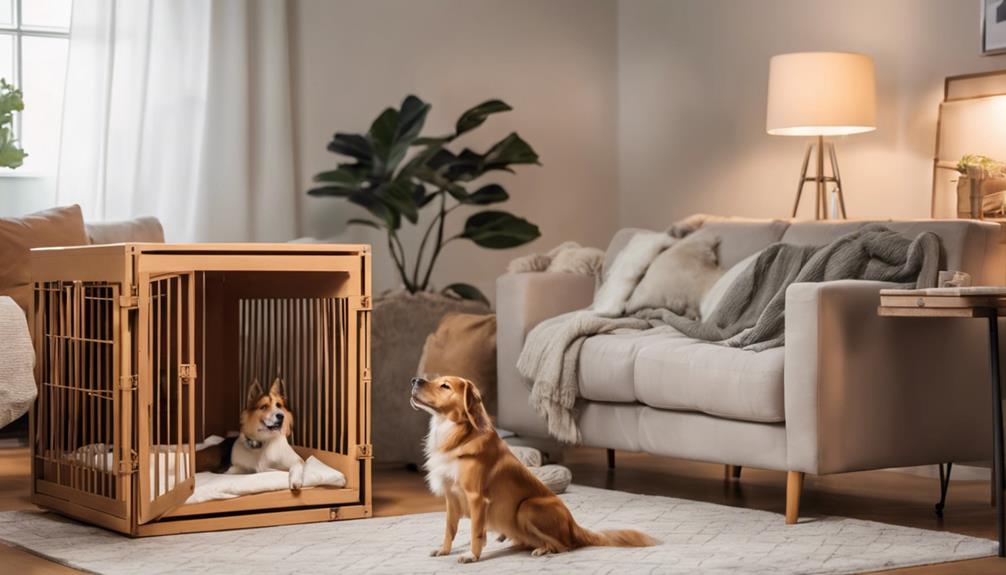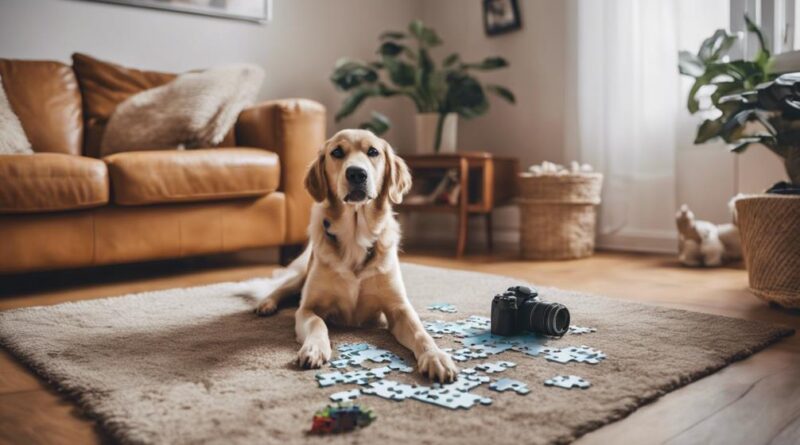How-To Guide: Alleviating Your Dog's Separation Anxiety
Imagine coming home to find your dog calm and content, no longer distressed by your absence. But how can you achieve this sense of peace for your furry companion?
By implementing simple yet effective strategies tailored to address their separation anxiety. From understanding the root causes to creating a supportive environment, each step plays a crucial role in helping your dog overcome their anxiety.
Ready to discover the key to a happier, more relaxed pup?
Understanding Separation Anxiety in Dogs
If your dog becomes anxious or distressed when you leave them alone, they may be suffering from separation anxiety. Canine emotions play a significant role in this condition, as dogs are highly social animals that form strong bonds with their owners. Understanding the behavioral triggers of separation anxiety is crucial to address the issue effectively. Training methods are essential in helping your dog cope with being alone, such as gradual desensitization to your departure.
To alleviate separation anxiety, it's important to implement coping mechanisms that can help your dog feel more at ease when left alone. Creating a safe and comfortable space for your dog, providing interactive toys, or using calming pheromones are some effective strategies. Additionally, establishing a consistent routine before leaving can help reduce your dog's anxiety levels. By recognizing the signs of separation anxiety and applying appropriate training methods and coping mechanisms, you can help your furry friend feel more secure and relaxed when you're not around.
Recognizing Symptoms and Behaviors
What common signs and behaviors indicate that your dog may be experiencing separation anxiety? Dogs experiencing separation anxiety may exhibit behaviors such as excessive barking or howling when left alone, destructive chewing, pacing, attempting to escape, or having accidents indoors even when house-trained. Other signs include drooling, panting, or trembling excessively before you leave or upon your return. Some dogs may also follow you from room to room and display clingy behavior.
Understanding these symptoms is crucial in addressing your dog's separation anxiety. It's essential to recognize that these behaviors stem from your dog's distress and not disobedience. Behavior modification techniques and a grasp of canine psychology can aid in alleviating your dog's anxiety. By acknowledging these signs early on, you can take proactive steps to help your furry friend feel more secure and comfortable when left alone. Remember, patience and consistency are key when implementing strategies to support your dog through this challenging time.
Establishing a Comforting Routine
Wondering how to create a comforting routine for your dog to help alleviate separation anxiety? Start by establishing a consistent schedule for your furry friend. Dogs thrive on predictability, so feeding, walking, and playtime should occur at the same times each day. This routine provides them with a sense of security and helps reduce stress when you're not around.
In addition to a consistent schedule, make sure your dog is surrounded by familiar surroundings. Create a designated area for your dog with their bed, toys, and blankets. This space should be a comfortable and safe retreat for them when you're away. Familiar scents and items can help your dog feel more at ease and less anxious during your absence.
Introducing Positive Reinforcement Techniques
To help your dog overcome separation anxiety, incorporate positive reinforcement techniques into your training routine. Reward-based training is a powerful method that focuses on encouraging desired behaviors by offering rewards when your dog behaves in a certain way. This approach helps your dog associate positive experiences with being alone, gradually reducing their anxiety.
Behavior modification techniques are essential in addressing separation anxiety. By using positive reinforcement, you can reward calm and relaxed behavior when you leave and return. For example, you can give your dog a treat or praise them when they remain calm as you prepare to leave the house. This helps them understand that staying calm leads to positive outcomes.
Consistency is key when implementing these techniques. Make sure to reward your dog every time they exhibit the desired behavior, reinforcing the connection between being alone and positive experiences. Over time, your dog will learn to associate being alone with rewards, making them feel more comfortable and secure when you're not around.
Creating a Safe and Relaxing Environment
Ensure your dog's environment is safe and conducive to relaxation by removing any potential hazards and creating a calm atmosphere. Start by securing any loose wires or small objects that your dog could chew on. Consider playing calming music in the background to help soothe your dog while you're away. Calming music can have a positive effect on your dog's mood and help reduce anxiety levels.
Additionally, provide interactive toys to keep your dog mentally stimulated and engaged, which can help distract them from any anxious feelings.
Interactive toys, such as treat puzzles or chew toys, can provide mental stimulation and entertainment for your dog while you're gone. These toys can help redirect your dog's focus from your absence to an enjoyable activity, making them less likely to experience separation anxiety.
Implementing Gradual Departures and Returns
Start practicing brief departures and returns to help your dog adjust to being alone gradually. This process can aid in reducing your dog's separation anxiety by getting them accustomed to your absence in a controlled manner.
Here are some tips to assist you in implementing gradual departures and returns effectively:
- Short Absences: Begin by leaving your dog alone for short periods, gradually increasing the duration over time.
- Calming Techniques: Use calming techniques such as providing interactive toys or playing soothing music to help your dog relax during your absence.
- Positive Reinforcement: Reward your dog with treats and praise when they exhibit calm behavior during departures and returns.
- Behavior Modification: Work on behavior modification techniques to address any underlying issues contributing to your dog's separation anxiety.
- Consistency: Maintain a consistent routine for departures and returns to help your dog feel more secure and predictable.
Seeking Professional Guidance and Support

If your dog's separation anxiety persists despite implementing gradual departures and returns, consider seeking professional guidance and support. Counseling sessions with a certified animal behaviorist or dog trainer can provide you with valuable insights and personalized strategies to help your furry friend cope better with being alone. These experts can assess your dog's specific needs, identify triggers for their anxiety, and tailor a treatment plan that suits them best. Behavioral therapy may also be recommended to address underlying issues contributing to your dog's separation anxiety.
Professional guidance can offer you the tools and techniques necessary to support your dog through their anxiety and work towards a happier, more relaxed state of mind when left alone. Remember, seeking help isn't a sign of weakness but a proactive step towards improving your dog's well-being. By collaborating with a professional experienced in canine behavior, you can enhance your understanding of your dog's needs and strengthen your bond through effective strategies and interventions.
Monitoring Progress and Adjusting Strategies
To effectively address your dog's separation anxiety, regularly assess their progress and make necessary adjustments to your strategies. Tracking improvements and modifying techniques are crucial in managing separation anxiety.
Keep a journal or use an app to record any behavioral changes and your responses to them. This will help you identify patterns and determine what strategies are working best for your dog.
If you notice setbacks or lack of progress, consider adjusting your approach. Behavioral changes may indicate the need for strategy adjustments, such as extending the duration of your departures more gradually or providing additional mental stimulation before leaving.
Frequently Asked Questions
Can Separation Anxiety in Dogs Be Completely Cured, or Is It Something That Will Need to Be Managed Long-Term?
You can manage separation anxiety in dogs through behavior modification and training techniques. While complete cure isn't always guaranteed, consistent efforts can significantly improve your dog's condition.
Natural remedies like pheromone diffusers or medication options prescribed by a veterinarian can also help alleviate symptoms. By creating a safe and comforting environment for your pup, you can minimize their anxiety and promote a sense of security when you're away.
Is It Possible for Dogs to Develop Separation Anxiety Later in Life, or Is It Typically Something They Experience From a Young Age?
Yes, dogs can develop separation anxiety later in life, not just from a young age. Late onset anxiety can be triggered by changes or traumas.
Senior dogs may be more prone due to age-related factors. Coping strategies like gradual departures, desensitization, and providing enrichment can help.
Understanding your dog's behavior and seeking support from a professional can make a big difference in managing separation anxiety in older dogs.
Are There Any Specific Breeds That Are More Prone to Separation Anxiety Than Others?
Certain breeds like Labrador Retrievers and German Shepherds have tendencies for separation anxiety, influenced by genetics and environment.
Behavioral training can help manage these issues. Patience and consistency are key in addressing the anxiety.
Understanding your dog's specific needs and triggers can aid in creating a comfortable environment for them. Remember, each dog is unique, so tailor your approach accordingly for the best results.
Can Changes in a Dog's Environment or Routine Trigger Separation Anxiety, Even if They Haven't Had Issues Before?
Changes in your dog's environment or disruptions in their routine can indeed trigger separation anxiety, even if they haven't shown signs before. Environmental changes like moving to a new house or sudden routine alterations can be behavioral triggers.
Preventive measures such as gradual adjustments to new environments and maintaining consistent routines can help alleviate potential separation anxiety in dogs.
How Can I Help My Dog Cope With Separation Anxiety if I Have a Busy Schedule and Can't Be Home as Often as I'd Like?
If you have a busy schedule and can't be home as often as you'd like, there are ways to help your dog cope with separation anxiety.
Try using interactive toys and enrichment activities to keep them occupied.
Crate training and desensitization techniques can also be helpful in easing their distress when you're away.
Consistent routines and positive reinforcement can make a big difference in managing your dog's anxiety levels.
Conclusion
Now that you have learned how to alleviate your dog's separation anxiety, remember to be patient and consistent in implementing these strategies.
By understanding your dog's behavior, establishing routines, using positive reinforcement, creating a safe environment, and seeking professional guidance when needed, you can help your furry friend feel more at ease when you're away.
With time and effort, you can make a positive difference in your dog's well-being and overall happiness.
